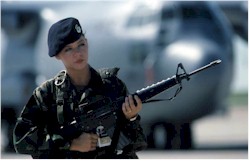|
This video was produced by the US
Marines as an instructional aid, demonstrating the safe use of the
M16A2. The video may be helpful to those using firearms in
their work, or those who may encounter firearms and need the knowledge
of safe handling of these weapons.
The video may be freely
downloaded.
|

The M16A2 rifle is a 5.56mm, magazine-fed,
gas-operated, air-cooled, shoulder-fired weapon that can be fired
either in automatic three-round bursts or semiautomatic single shots
as determined by the position of the selector switch.
-
The upper
receiver and barrel assembly has fully adjustable rear and front
sights and a compensator that helps keep the muzzle down during
firing.
-
A rubber pad
mounted on the butt stock and a buffer assembly inside the butt
stock helps absorb the recoil when fired.
-
The barrel is
surrounded by two aluminum lined Fiberglass hand guards which are
notched to permit air to circulate and cool the barrel and also
protect the gas tube.
-
A bayonet and/or bipod
can be attached to the barrel of this weapon individually or at the
same time.
------------
Helpful Tips in Using this Weapon
- Although the projectile will travel
up to two miles, its' maximum effective range is about 300 meters,
in practiced hands, in daylight, with a stationary, man-sized
target. Most medical personnel won't be able to achieve those
results, so try to hold your fire 'til you "see the whites of their
eyes."
- Effective rifle fire, other than at
point blank range, requires careful sighting (aligning the front and
rear sights with the target), breath control (try not to breath
while firing), a smooth, steady trigger pull (try to avoid jerking
the trigger), and avoidance of "flinching" in anticipation of the
weapon firing. The latter can be avoided through practicing "dry
fire" techniques.
- In the event of a misfire, try the
Slap, Rack, Bang procedure:
- Slap
the magazine upward to more firmly seat it in the weapon.
- Rack
back the "Charging Handle" and release it, ejecting the misfired
round and bringing a fresh round into the firing chamber. Let the
the "Charging Handle" spring back on its' own...don't "ride" it
back.
- Bang
goes the rifle when you pull the trigger.
- When defending against multiple
targets, try to stop the most threatening target first. Usually that
is the target closest to you. However, someone with an automatic
weapon or shotgun is more dangerous to you and your patients than
someone with a pistol. Likewise, someone with a rifle is more
dangerous than someone with a pistol.
- Take advantage of any cover you may
have. Crouching behind a rock or packing crate is much better than
standing out in the open. If you are caught out in the open, quickly
make a decision to either go to the ground, or to run to cover. If
you go to ground, keep moving (rolling, crawling), to decrease the
chance of your being wounded.
- Should you become wounded, keep
shooting. The best defense against incoming fire is to return fire,
wounded or not.
From Operational Medicine 2001
|

